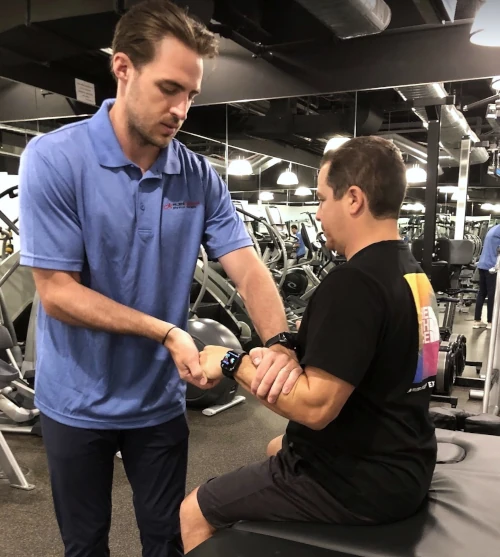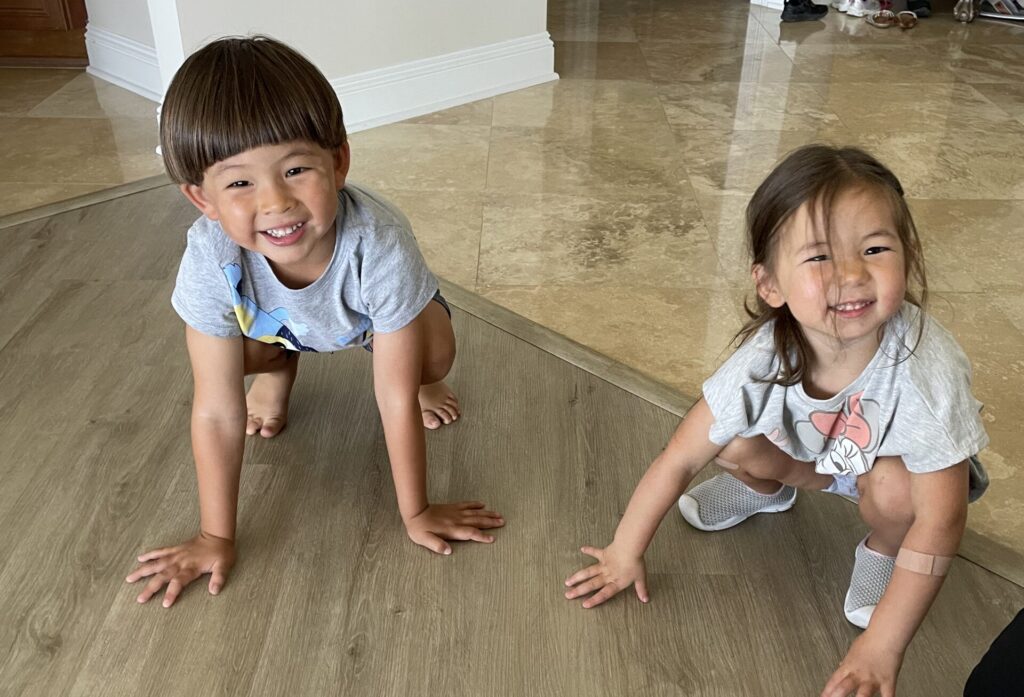

Pediatric Physical Therapy at Home in New York City
What’s Pediatric Physical Therapy for Toddlers Look Like?

Using the therapy ball allows us to work on dynamic balance. By safely shifting the baby’s weight on an unstable surface, we trigger their natural reflexes to stay upright, engaging their core as well as their shoulder and hip stabilizer to give them the stability they need to then be able to do fine motor tasks like grasping.
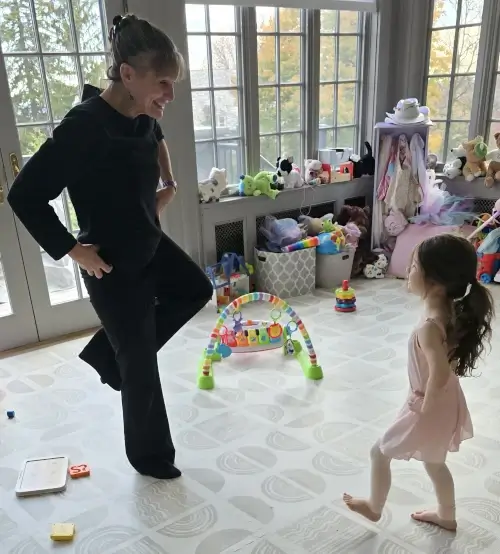
We use exercises like “Single leg stance” with hands on hips to have the child work on hip and core stability, taking away strategies like using the arms to keep their balance for them. This exercise also helps kids begin to activate their balance reactions in their ankles to enable them to do higher level skills like running and playing on uneven surfaces without falling or twisting an ankle.

A baby’s job is to play and explore. By engaging the toddler in a preferred activity, we are able to then use our hands to facilitate the muscle engagement we want, with improved alignment and body mechanics, and without them feeling like they are doing work. In this way, we are able to help them progress their gross and fine motor skills.
The Latest Research & Study Supporting the Effectiveness of Pediatric Physical Therapy
- Multimodal physical therapy treatment including vestibular rehabilitation (balance & coordination training) improves post concussion symptoms in pediatric patients and early initiation of vestibular rehabilitation might demonstrate better outcomes. Click to read the research. https://www.sciencedirect.com/science/article/abs/pii/S0003999324007925
- This study looked at how physical therapy helps children with conditions like spina bifida, torticollis (twisted neck), and cerebral palsy get stronger, move better, and improve their overall development. The study also found that physical therapists do more than just help kids with their physical challenges. They also help them build confidence and become more independent. Click to read the research. https://pmc.ncbi.nlm.nih.gov/articles/PMC10680406/
- This study determined physical therapy helps children with autism who struggle with movement, balance, and coordination. By assessing their needs and creating a customized program, physical therapists can improve gross motor skills like walking and running, as well as balance and coordination skills needed for activities like climbing stairs or jumping. They also focus on strengthening muscles for better support and endurance, and improving functional mobility for greater independence in daily life. Click to read the study. The Role of the Pediatric Physical Therapist for Children on the Autism Spectrum
What is Pediatric Physical Therapy?
What is Pediatric Physical Therapy?
Movement is important at all stages of life; and individuals may have challenges with this at any of these different stages. However, newborns, infants, children and teenagers are not just little adults. Their body’s structure, and how their body responds to interventions are different, and treating a child similarly to an adult can result in injury. When a newborn, infant, child or teenager has challenges with posture, alignment, developmental skills, balance, coordination, strength and stability, flexibility, pain, or performing functional/ play/ sports related skills, a pediatric physical therapist can help.
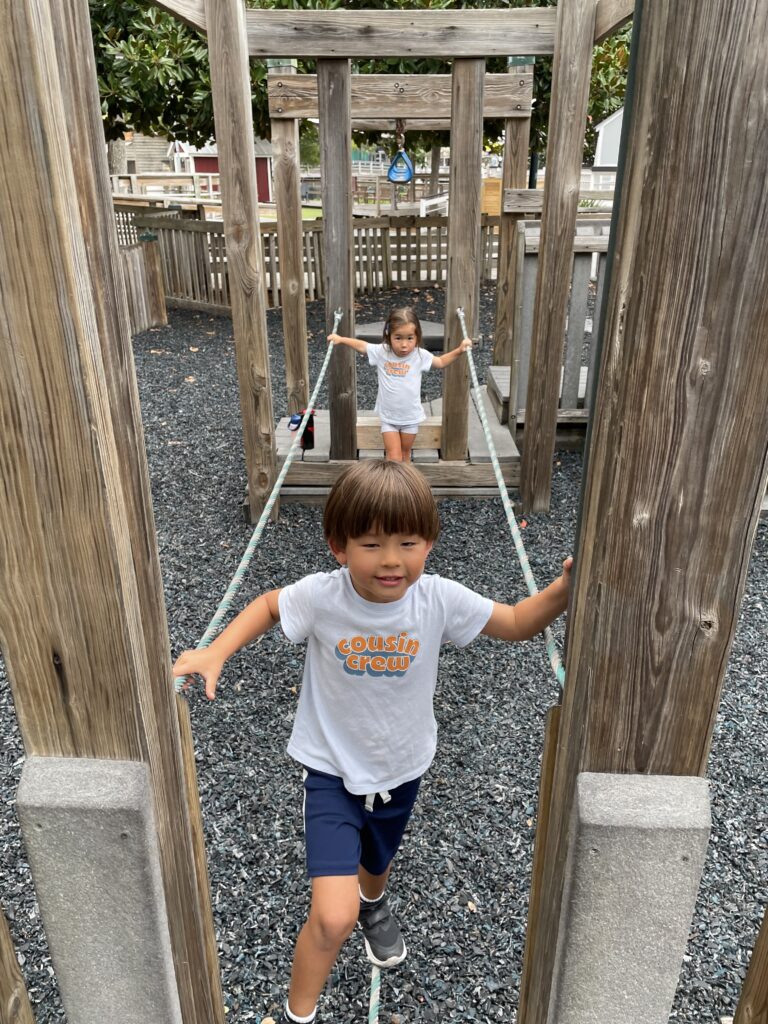
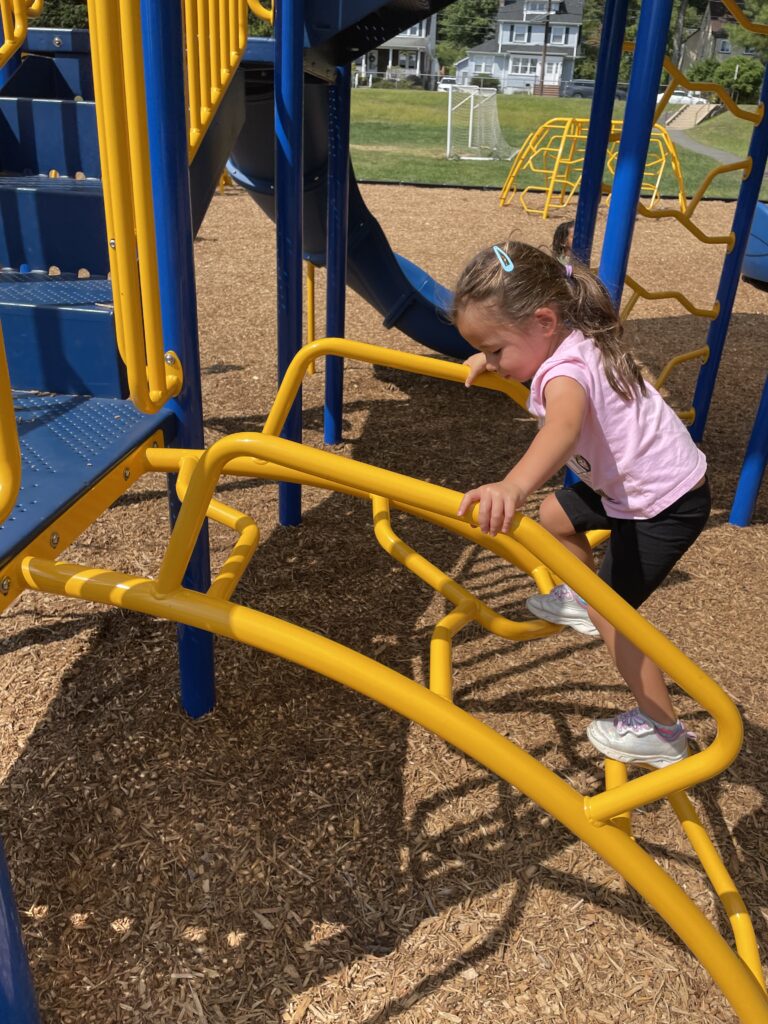
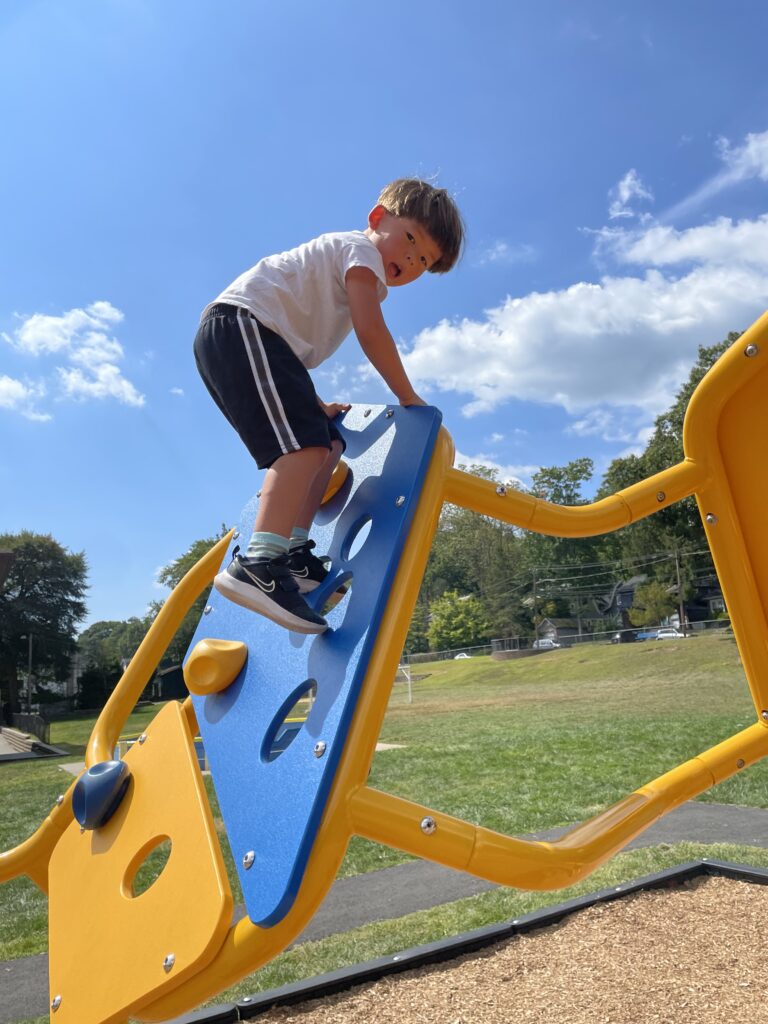
Palmer Concierge Physical Therapy has therapists that specialize in various areas of pediatric physical therapy including: Developmental PT, Vestibular PT, and Sports Performance, Sports Injury Prevention and Sports Injury Rehabilitation; as well as Pediatric Rehabilitation due to injury or illness. This differs from clinic, hospital, school based and Early Intervention physical therapy in that it is provided at a time and place of your choice, focuses on more than just minimal functional standards, is able to be initiated in a timely manner (rather than waiting on a wait list, or in terms of early intervention – until your child is 2 standard deviations behind their same aged peers to then begin therapy). In addition, babies who are medically fragile, might not yet be fully vaccinated, are possibly immunocompromised due to prematurity or other reasons, or are at higher risk of illness during “respiratory season” can have this risk decreased by not having to navigate crowded areas like public transit and waiting rooms.”
Could Pediatric Physical Therapy At Home Benefit Your Child?
Could Pediatric Physical Therapy At Home Benefit Your Child?
Our physical therapists provide developmental therapy and specialized support for preemies or infants with extended NICU stays, serving patients from newborns to teenagers, including:
Infants with:
- Torticollis
- Club Feet
- Calcaneovalgus
- Cranial malformations
- Chronic lung disease or heart disease affecting your baby’s posture and/or function
- Gastrointestinal dysfunction (sometimes requiring abdominal surgeries, and
- delaying tummy time as well as resulting in bound down abdominal scarring)
Infants who experienced the following at birth or before birth:
- Exposure to toxins (at times prescribed medications that pose challenges to newborns, or accidental non-prescribed substances)
- Loss of oxygen
- Shoulder dystocia
Infants, toddlers, children and teenagers with:
- Developmental Delays
- Challenges of balance, stability and coordination
- Congenital or Genetic Disorders
- Autism Spectrum Disorder
- Cerebral Palsy
- Altered muscle tone – low, high, ataxic, athetoid
- Sensory Challenges
- Deficits resulting from accidental or non-accidental trauma
- Deficits resulting from prolonged illness, surgeries or hospitalization
Especially when working with young clients, PT Krissy finds it most beneficial to work with the client, but also spend time teaching the client’s caregivers how to carry over what is done within the session, between sessions. (This may be the parent, grandparent, daycare provider, nanny or other individual designated by the client’s caregiver.)
What Parents Can Expect in their First Session?
Pediatric Physical Therapy At Home: What Parents Can Expect in their First Session?
The first step in the pediatric physical therapy journey is a thorough baseline evaluation: observation of any positioning or mobility equipment that your baby or child is using.
The evaluation is a time for the parent to voice questions and concerns about pediatric physical therapy. We review all information and then collaborate with parents, where appropriate the child, and in some cases other professionals involved to determine objectives, aligned to and targeting the child’s functional deficits, delays, injuries or recovery goals.
Your child’s physical therapy treatment plan may include different therapeutic modalities, including:
- Positioning and handling (that the PT will perform and also teach you) to help facilitate developmental milestone progression.
- Education regarding barriers to progression, and different activities and toys to help progress toward the next stages; or in the case of premature babies, identifying and limiting stimulation that may be too much for them.
- Scar massage to help loosen bound down surgical scars that may be limiting movement.
- Strategies for helping babies who can’t regulate their state (are either asleep or awake and crying) improve their transitions and ‘quiet and active alert periods’ so that they can be awake, happy, exploring their environment and playing.
- For children with ASD, sensory and movement strategies that can be integrated into your child’s day to help them function more easily and comfortably throughout the day.
- Activities for increasing: strength, balance, stability, coordination, motor planning, body awareness, muscular length, endurance and postural alignment.
- Play that incorporates breath work, calming the nervous system, and grounding.
Our objective is that through working with your child and yourself; that we can help make movement, play, and exploration easier, safer and more enjoyable; so your child can grow, develop and more easily participate in activities they enjoy, including those with their peers.
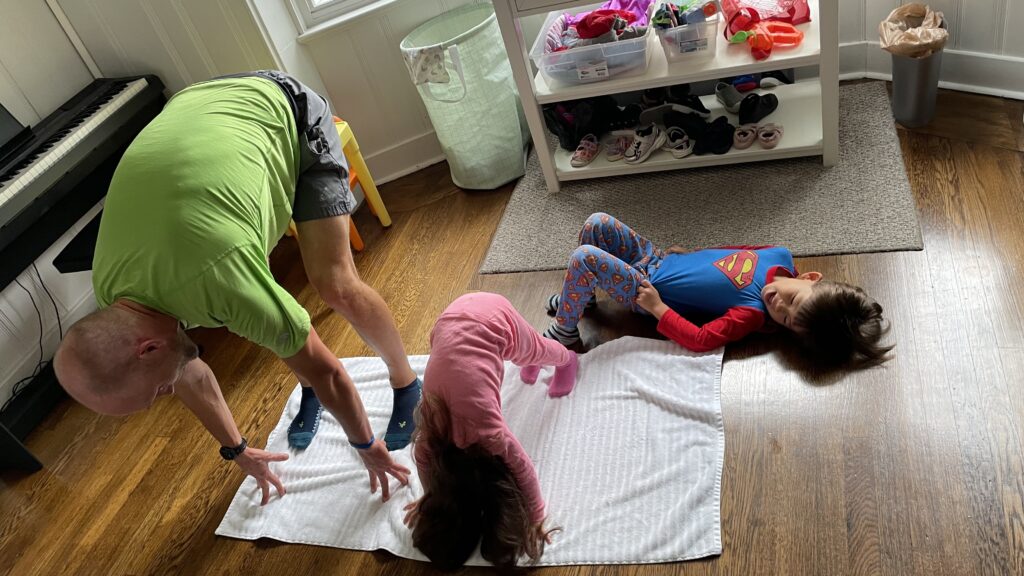
Key Benefits of Pediatric Physical Therapy for Babies & Toddlers
Key Benefits of Pediatric Physical Therapy for Babies & Toddlers
- Helps in the transition between a prolonged NICU stay and independent care of a preemie or medically fragile baby.
- Improves asymmetries, so that equipment such as helmets can be avoided, alignment is improved to preserve joint development, and developmental milestones can more easily be achieved.
- Addresses developmental challenges and delays early so that they have less of a chance of progressing as far, can be addressed more easily, and decreases frustration of a baby who wants to play, but motorically is challenged to.
- Increases your child’s sense of confidence and independence.
- Increases a child’s ability to participate with their peers and in a larger variety of activities, both through improving their skills, and helping to modify equipment needed to do so.
Signs Your Baby Might Need Physical Therapy
Signs Your Baby Might Need Physical Therapy
- Your baby is either asleep, or awake and crying; without any intermediate states.
- Your baby demonstrates a neck preference and/ or has flattening on part of their head that makes it hard for them to keep their head in the middle.
- Your baby doesn’t tolerate tummy time and/ or can’t lift and turn their head when on their belly by 3 months.
- Your baby keeps their thumb(s) in the palm of their hand, unable to bring them out (as is needed for grasping), past __ months.
- Your baby isn’t bringing their hands to their mouth or together by 3 months.
- Your baby isn’t accepting weight through their legs when supported by 6 months.
- Your baby can’t sit unsupported by 8 months.
- Your baby isn’t pulling to stand, standing at a support surface and starting to cruise by 12 months.
- Your baby is showing a hand, arm or leg preference before 3 – 4 years old.
Signs Your Child Might Need Physical Therapy
Signs Your Child Might Need Physical Therapy
- Your child trips and falls a lot, bumps into others when walking, or tends to walk with one side of the body touching a wall.
- Your child tends to slouch or lean to one side.
- Your child repeatedly gets picked last for teams, or can’t keep up with his peers.
- Your child wears out the toes of their shoes before the rest of the shoes are worn in; or walks on their toes/ forefeet.
- Your child tires out before their peers walking through the halls, going up stairs, or playing outside.
- Your child isn’t able to sit still in class, at the table for meals or for any activity long enough to finish; needing to get up and move, fidget, or demonstrating challenging behaviors
Pediatric Physical Therapy for Sports Injuries
Pediatric Physical Therapy for Sports Injuries
Participating in sports is an excellent way for children and teens to enjoy regular exercise while learning all about teamwork, perseverance, and leadership. Unfortunately a side effect of youth sports is the occasional injury that requires pediatric physical therapy to properly heal.
The bones, muscles and joints of children and teens require special care. Growth plates—tissues at the ends of bones in children and teens that influence the future shape and length of the bone once mature —are still open and vulnerable to damage. Should growth plates become injured, and not diagnosed or treated correctly, it can lead to long term debilitation leaving children and teens permanently sidelined from the activities they enjoy.
Some of the most common sports injuries that children and teens experience are due to impact (with other players or objects like balls) and repetitive motions or overuse and include:
- Ankle injuries
- Pulled muscles
- Shin splints
- Knee injuries
- Tennis elbow (tendinitis)
- Hip flexor injuries
While children and teens do recover faster than adults from injury, they should still be treated and as soon as possible once suffering an injury. Beginning therapy early enables the young athlete to benefit from joint mobilization and manual soft tissue massage to decrease any inflammation and initial pain resulting from an injury. Treating sports injuries purely with rest and medication does not target the movements, skills, and strength demands for your child to safely return to a sport with a reduced risk of re-injury. In rehabilitating your child, we will have them safely perform exercises that mimic the specific motions and stressors they will experience when they return to their sport. Upon completion of a tailored treatment both you and your child should feel confident that they can return to their sport without fear of injury.
Patients often have to wait weeks or months to gain access to providers—long enough for conditions to move from acute to chronic. The Palmer Concierge PT Team brings physical therapy to you, to meet your wellness goals with the convenience of a mobile service that comes to your home, office or hotel. Our goal in providing personalized one-on-one care is to help you achieve a pain-free and healthy lifestyle. We offer a mobile physical therapy experience in New York City, Brooklyn and the Hamptons that empowers, educates, and restores balanced healthy movement without the drive to appointments, having to re-schedule your day, or cope with crowds and traffic.
–The Palmer Concierge PT Team
